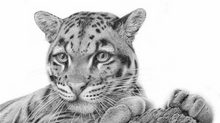In search of the world’s rarest wolf
- Vincenzo De Luca
- Apr 14, 2022
- 3 min read
Updated: Jan 13, 2023
It was only in 2013 that I realised that Africa actually has a species of wolf. However, in my defence, it would appear that scientists haven’t been too sure what the animal should be classified as either! It has previously been known as the Simian Jackal and Simian Fox and, when you look at it you can see why it was called both, for it has the colouring of a fox and the long snouted head of a jackal. However, the current thinking is that this creature is distantly related to the Grey wolf of Europe and that some early ancestors were marooned in Africa over a hundred thousand years ago. Adapting to their highland environment, and being the only wolf which now predates mainly on rodents, this creature was to evolve into the Ethiopian or Abyssinian wolf that we see today, the most threatened carnivore in Africa and the rarest canid in the world.

The Ethiopian wolf lives in seven areas within the highlands of Ethiopia. They are found at over 3000 metres and the largest number are to be found in the Bale mountains and national park. There are currently about 450 wild wolves in total in Ethiopia. None are to be found in captivity, either within Ethiopia or ex situ, as the government doesn’t allow it, and there is therefore no captive breeding programme. They are a protected species, classified as endangered, but due to farming encroaching yearly upon their mountain habitat, their range is reducing. They are also prone to contracting rabies and canine distemper from the local farm dogs. If one wolf contracts the disease it is not unusual, due to their greeting rituals, for the entire pack to become infected and to be wiped out.

A pack of Ethiopian wolves. Photo copyright Jon Isaacs 2022
Fortunately, due largely to the efforts of Professor Claudio Scillero, who has developed The Ethiopian Wolf Conservation Plan, hope still exists for this species. Every year, as many farm dogs as possible, currently over 5000, are vaccinated against the disease and the results recently have been encouraging. A programme of education has also been introduced to encourage the villages to help the vets and vaccinating teams in capturing the semi wild farm dogs for vaccination. Less rabid dogs, in particular, equals healthier villages, less prone to contracting rabies and more wolf packs. The use of translocation is also helping to keep the numbers of the seven groups viable. Researchers from organisations such as Born Free are studying the wolf, especially in the Bale National Park, and it is hoped that this rarest and most interesting of canids will maintain viable populations and survive well into the foreseeable future.

Having read about this amazing wolf I wanted to see and photograph it for myself. I consequently booked on a group tour of Ethiopia which included a couple of trips up onto the Sanetti plateau in the Bale Mountains to try and see this superb looking animal. The first trip yielded only a few long distance sightings. On the second trip, the weather at 4000 metres was awful and a blanket of mist reduced visibility to a few yards. It was bitterly cold and snow flurries occasionally swept across the terrain. The weather was hardly ideal for wolf or human to be out in the rarefied atmosphere.
Our group saw little as we travelled the muddy and flooded road. Spirits were low but, as this was our last chance to see the rarest canid in the world we persevered. An hour before sunset the mist lifted, the cloud broke and the sun’s rays streamed down. Within minutes a wolf loped across the road. We photographed it as it explored and scent marked its territory. The stunning creature then set off across the undulating plateau, where we tracked it through binoculars and scopes. To our amazement it paused, started to howl, and within a few minutes we were watching the entire pack of eight through a scope, down in the valley. They had come together after their solitary hunting, with much greeting and playful socialising.
It was undoubtedly one of the highlights of my years spent watching wildlife. I just hope that the wolves will be around for a long time to come, so that many other people will be able to enjoy the spectacle that I was privileged to see.
As it is rarely chosen as an art subject, I wanted an extremely talented artist to depict one of my sightings of a wolf crossing some melt water in a valley. Needless to say I chose David, who produced an incredibly detailed picture of the scene I witnessed. Nobody could have done it better!
I














































Comments